10 Safe Canned Foods for Baby-Led Weaning: What to Buy (and What to Avoid)
- Learn which 10 canned foods from the 100 First Foods list are actually safe and easy for your baby to eat
- Decode confusing canned food labels so you can confidently choose low-sodium, no-added-sugar options.
- Avoid the common mistakes parents make in the canned food aisle — and know exactly what to steer clear of.
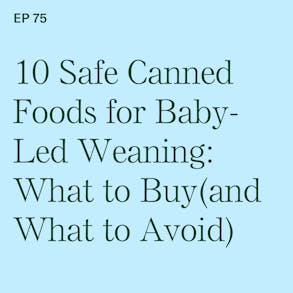
LISTEN TO THIS EPISODE
Episode Description
Most parents think everything their baby eats has to be fresh, homemade, and cooked from scratch…but that’s just not true. In this episode, I’m breaking down 10 safe canned foods from my 100 First Foods list that can make starting solid foods easier, cheaper, and more realistic for busy families. I’ll share why certain canned foods actually work better than fresh, how to spot the low-sodium and no-added-sugar versions, and the quick label checks I use to make sure a canned food is safe for babies.
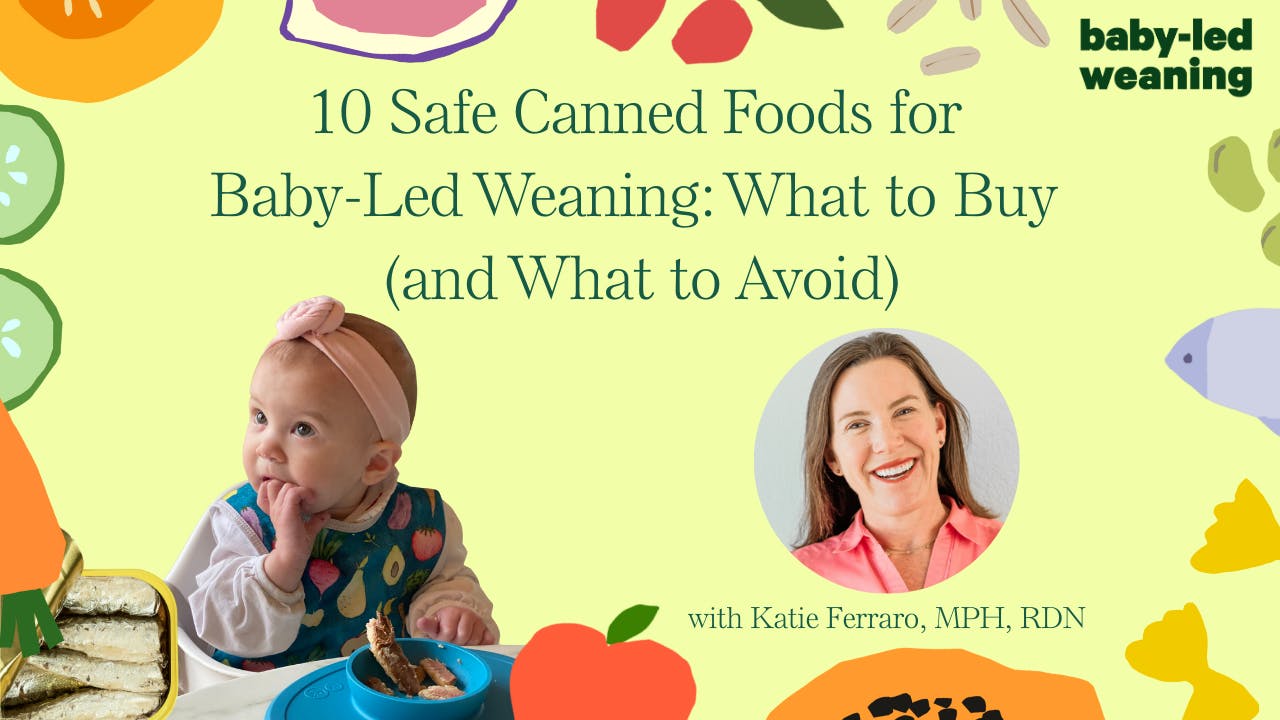
Links from this Episode
- Baby-Led Weaning with Katie Ferraro program with the 100 First Foods™ Daily Meal Plan, join here: https://babyledweaning.co/program and get $50 off when you sign up using the code BLWPOD50
JOIN NOW AT $50 OFF CODE: BLWPOD50
- Baby-Led Weaning for Beginners free online workshop with 100 First Foods™ list to all attendees, register here: https://babyledweaning.co/baby-led-weaning-for-beginners

Latest Episodes
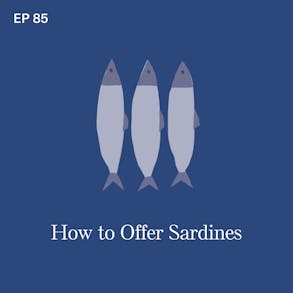
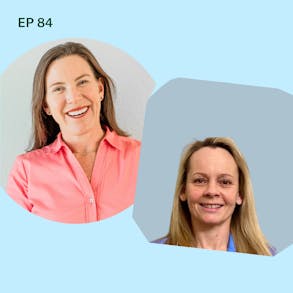
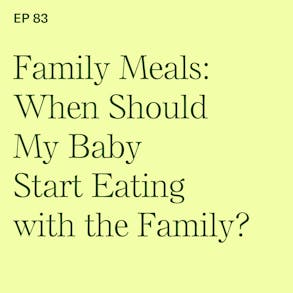

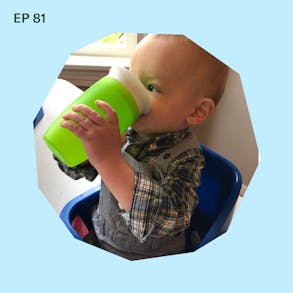
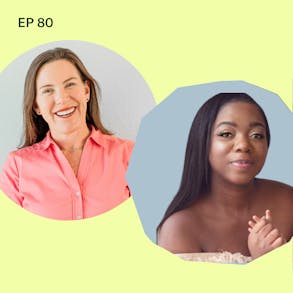
Rula (1s):
Can we be real about productivity for a moment, especially productivity post babies. I used to be the most productive person in the world because I really only had to worry about myself. And I feel like the more people that I've brought into the world, I'm like, what happened to all of my time? And why can't I get anything done? Let's be real. Our culture is weird about productivity. You are now just supposed to magically be able to still do all the things, right? Parent and work and manage a household, maybe keep a friendship or two alive and never slow down. Oh yeah. And work out and maybe be nice to your partner or spouse. That to-do list, it just never gets done. I have two sisters and one of my sisters who's self-employed, she's like very productive. And we were talking the other day like, okay, what if you, she's like, imagine this. You got everything on your to-do list done in a day. Like what would that actually feel? Feel like you worked out, you fulfilled all your obligations. What would you feel like? And she said, you would feel like a robot, right? Guess what? You're not a robot. You're not a machine. If you're feeling burnt out or anxious or stuck, you are not alone. Therapy can help, but therapy also has to be accessible and affordable. And that's where RULA comes in. Rula connects you with a licensed therapist or psychiatrist based on your needs and your schedule. So you answer a few questions and Rula finds someone who matches your preference and they take your insurance. So the average copay, it's only $15 per session. Seriously. And because Rula supports every step of your journey, including checking in to make sure that you're actually making progress, it doesn't feel like you're doing this alone. Thousands have already trusted ruler to support them on their journey towards improved mental health and overall wellbeing. So if you head over to rula.com/weaning, you can get started today. After you sign up, they'll ask you where you heard about them. Please say Baby led weaning with Katie Ferrara podcast to help support our show. Go to RULA.com/weaning and take the first step towards better mental health today because you deserve quality care from someone who cares and you are not a robot.
PayPal (2m 10s):
Get your mother loving ears on because your big time radio DJ's got news. PayPal lets you choose how you want to pay for all the stuff. With PayPal. I can pay in store, pay online, or pay over time. What's that? You want this translated into song? I hope you're sitting down. You can pay your own way. You keep those ears on. You hear, don't just pay baby PayPal. Learn more@paypal.com.
Katie Ferraro (2m 40s):
Most parents think that everything their baby eats has to be fresh and homemade and perfectly cooked from scratch, but that is just not true. In fact, some of the best and even the safest foods for baby-led weaning actually come from a can. Hey there, I'm Katie Ferraro, registered dietitian, college nutrition professor and mom of seven specializing in baby-led weaning. Here on the baby-led weaning with Katie Ferraro podcast. I help you strip out all of the noise and nonsense about feeding, giving you the confidence and knowledge you need to give your baby a safe start to solid foods using baby-led weaning.
Katie Ferraro (3m 21s):
Today I'm gonna show you 10 foods from my hundred first foods list that you can feed your baby from a can. Now, a few of these might surprise you, especially the one fruit that's actually better canned than fresh for babies. I'm gonna break down exactly what makes canned food safe, how to read those confusing labels, and how to choose the right canned foods so that you feel confident when serving them to your baby. Now I like to start these mini solo trainings out with a baby led weaning tip of the day. And today's tip is that rinsing canned foods under the faucet can reduce their sodium by about 30%.
Katie Ferraro (4m 3s):
Now why does that matter? Because we're gonna be talking today about trying to find no added salt or no salt versions of canned foods for babies. And I'll explain why in a second. But if you can't find them, if you rinse the canned foods under the faucet, it's gonna reduce the sodium by about 30%. Now, you're also gonna be rinsing off, you know, sodium serves as a preservative. So after rinsing those foods, you do wanna refrigerate them and serve them within one to two days. And then you never wanna store rinsed foods back in the can and hang tight because I am going to be explaining exactly which versions of the canned foods are going to be safe for your baby to eat. Now a couple of fun facts about canned foods before we get started.
Katie Ferraro (4m 43s):
I was surprised in researching this episode to learn that canned foods were actually invented because Napoleon needed to feed his army. So in 1795, Napoleon offered a cash prize to anyone who could find a way to preserve food long term. So the purpose was he wanted to like better feed his army when he invaded a country or was not able, like they weren't inclined to like sell or provide food. Basically 15 years later, the confectioner Nicholas Francois Aper claimed the prize. He devised a method that involved heating and boiling and ceiling food and airtight glass jars, which is basically still the same technology used to canned foods. The first consumer canned food, ugh, I was surprised to find out it was oysters and canned meat.
Katie Ferraro (5m 28s):
They were sold in tiny tin cans back in 1813. So we're gonna be talking today about some canned proteins that are safe for babies to eat. So hang tight. One last fun fact, this one's weird. The canned opener was actually invented 48 years after canned food was people literally used to open their canned foods with hammers and chisels. Thankfully, times have changed. Alright, why do canned foods work for babies? Okay, not all the food that you offer, your baby has to be fresh. All right? I wanted dispel the myth that canned foods are unsafe for whatever reason. Sometimes you hear that canned foods definitely are safe, okay?
Katie Ferraro (6m 9s):
The reason why canning works is because bacteria cannot grow in an airtight heat sterilized environment. Okay? So canning like it might sound high tech, but it's actually like very incredibly simple. Canned foods offer an opportunity to offer your baby a consistent texture, softer foods, and access to out of season items. Okay? So I've got a list of a hundred foods that your baby can eat before they turn one, but I also know that not all those foods may be seasonally available for you. So getting canned versions of them is a very efficient and budget friendly shortcut. And I'm gonna show you 10 of the foods from the hundred first foods list that work for baby lead weaning.
Katie Ferraro (6m 52s):
If you don't yet have a copy of my original hundred first foods list, I give it away to everybody for free on my online workshop called Baby Led Weaning for Beginners. So you can get signed up for that workshop and grab a copy of that a hundred first foods list, put it on your refrigerator, start knocking the foods off for your baby. You can get signed up for that free workshop called Baby Led Weaning for Beginners. If you go to baby led weaning.co/workshop. So I mentioned that canned foods are a budget friendly way to offer foods. The price of food can be all over the board, especially when we're talking about fresh foods. But canned foods for the most part are relatively affordable and they're definitely convenient.
Katie Ferraro (7m 33s):
So I wanna talk for a second about label rating and two particular parts of the label. I know it can be annoying when you turn a canned food over and you're like, oh my gosh, there's so many words, but just lock in on two nutrients that matter for babies, sodium and added sugars. When it comes to sodium, we want to stick to as low of sodium options as possible, right? There's some natural occurring sodium in some of the foods your baby's going to eat. But the reality is, most of the foods you offer your baby, you're making 'em at home. They're wholesome whole foods without a lot of added salt. That's great. When we look at canned foods, you might think, oh my gosh, I can't believe she's a dietician recommending canned foods for baby lead weaning because they're so high in salt.
Katie Ferraro (8m 13s):
A very small percentage of the actual sodium that the typical person eats comes from canned foods, okay? You can get really high salt versions of foods, but you can also get no added salt versions of foods that come in cans as well. So look for no added salt. There's a little bit of a terminology that sometimes like a lot of these words sound the same, and you're like, doesn't it all just be the same? And it doesn't. When it comes to sodium, the term low salt on the front of a package means it has 140 milligrams of sodium or less. To put things in perspective, I generally recommend less than 100 milligrams of sodium per serving of a food that you're going to serve your baby. There's no real hard and fast guidelines about sodium for babies. And the reality is those serving sizes that are posted on a label, your baby's never never gonna eat that much either.
Katie Ferraro (8m 56s):
And the canned foods are a sometimes food, but try to say to less than a hundred milligrams of sodium. So some just 'cause something says low salt, doesn't mean it's gonna fit that bill. Now, reduced sodium, you might be like, oh, that's a good option. But all reduced sodium means is that it's 25% less sodium then it's regular counterpart. So think about soy sauce, for example. Soy sauce is liquid sodium, and if you get reduced salt or reduced sodium soy sauce, it's just 25% less salt than the liquid salt. It doesn't mean that it's low salt by any stretch of the imagination. Okay? So we wanna look for no added salt or no salt, and then turn your label over. And as close to zero as you can get is the best option.
Katie Ferraro (9m 36s):
And again, remember when you're talking about canned foods, if you can't find the lowest sodium version possible, re rinsing that product underneath the faucet, we'll reduce the sodium by about 30%. I'll give you an example of garbanzo beans. Okay? If I go to my grocery store in my town, there's three versions of the same brand of garbanzo beans. There's the regular garbanzo beans, just says garbanzo beans are chickpeas. Okay? And that's one of the foods on our hundred first foods list. It's a great way to offer your baby a plant protein. It's pretty decent amount of iron and fiber. If you just get the regular garbanzo beans, a half a cup of that would've 420 milligrams of sodium, eh, too high for a baby. The low sodium version is gonna have 140 milligrams of sodium, but there's a no added salt version that has zero milligrams of sodium.
Katie Ferraro (10m 25s):
They all cost the same, they all have the same amount of protein, the same amount of fiber, the same amount of iron except you. The one with zero milligrams of sodium is the best bet for your baby. Let's let your baby learn how to taste the actual food and not the salt that gets added to it. And it costs the same. So if you got stuck and you couldn't buy the no added salt one, get the low salt one at 140 milligrams, rinse it under the sodium or rinse it under the faucet, and you're gonna be down to about 92 milligrams of sodium. Okay? Again, I don't want you measuring milligrams of sodium and you can't even do that. But the point is, we're trying to minimize the amount of salt when it comes to sugar. We're not gonna see sugar in canned vegetables, which you definitely might see sugar in canned fruits that you might be offering to your baby.
Katie Ferraro (11m 10s):
So I want you to look at the added sugars line. So underneath carbohydrate on the label, there'll be a line that says added sugars that we wanna get as close to zero grams of added sugar. And ideally we want zero grams of added sugar. The American Academy of Pediatrics recommends no added sugar for children up until age two. So yeah, there's sugar and fruit, but that's naturally occurring sugar and that's perfectly fine for your baby. What we don't want is to put it in a can with a bunch of added sugar. So some of the terminology that you're looking for if you're buying canned fruit is look for fruit packed in water or packed in its own juice or packed in a hundred percent fruit juice. Generally. We also don't recommend fruit juice for babies. Again, the American Academy of Pediatrics recommends no fruit juice for babies, for children under two.
Katie Ferraro (11m 55s):
I believe fruit baby doesn't need fruit juice, but if it's from fruit that's packed in the fruit juice and you take the fruit outta the fruit juice and give it to the baby, that's perfectly fine. What we don't want is the fruit packed in light syrup or syrup or heavy syrup, okay? So I was looking at a couple of different canned fruit items at my regular grocery store and there were peaches, okay? So there was peaches packed in a hundred percent fruit juice that had no added sugar. There was peaches packed in light syrup that had six grams of sugar per serving, and there was peaches packed in heavy syrup that had 13 grams of added sugar. And just to put that in context, if you think about like the a teaspoon of sugar or a sugar packet like you would get at Starbucks, that's four grams of added sugar.
Katie Ferraro (12m 37s):
So if you are buying peaches packed in heavy syrup that has 16 grams of added sugar, that's like giving your baby peaches with four packets or four teaspoons of sugar. Sprinkle on that. Okay? We don't wanna do that. No added sugar for babies, stick to the ones with zero grams of sugar, and also just do a little bit of sleuthing there because a lot of those brands are gonna put artificial sweeteners in there in order to make the added sugars line look like zero grams of sugar. We also don't want artificial sweeteners for babies either. Now a word about canned food safety, sometimes parents will be like, oh, but canned foods are unsafe. And be like, why would canned foods be unsafe? Okay, the really, the only instance I can think of where a canned food would pose a safety problem for any of us babies included, would be the potential for botulism.
Katie Ferraro (13m 21s):
Okay? So sometimes commercially canned foods from the grocery stores, the truth is they're extremely unlikely to cause botulism. Large manufacturers are using high heat, high pressure sterilization, okay? And what this process does is it specifically targets clostridium botulinum, then that's the bacteria that's gonna cause botulism. Okay? And that's a neurotoxin that's dangerous and harmful for babies and adults. Okay? So canned foods are actually one of the most strictly regulated low risk food categories, okay? Botulism from store-bought foods, very, very rare botulism risk, though it is associated with home canned foods, okay? So if they're improperly canned, especially low acid foods, or if you're eating canned foods that come from bulging or leaking or dented or rusted cans, let's steer clear of those.
Katie Ferraro (14m 9s):
Okay? For babies, we wanna avoid feeding a baby any food from a can that looks compromised, okay? So any can that's bulging. If it's strong sign of gas production from bacteria, if it's leaking, if it's badly dented, especially at the seams, if it's rusty or swollen at the ends, those defects can allow bacteria to grow or to break the seal. So when in doubt, throw it out. Let's talk next about the 10 foods and how to choose foods that your baby can eat that come from a can. So the way it was hard for me to narrow down to 10, okay, I could do canned foods all day long. I freaking love canned foods because they're so easy. This is a low lift, easy way for you to offer a variety of new foods for your baby. So what I did was I went through my hundred first foods list, and there's five categories on the list.
Katie Ferraro (14m 53s):
So there's 20 foods in each category. That's how we get to 105. There's fruit category vegetables, there's starchy foods, proteins, and allergenic foods. So there's 20 fruits on the list, 20 vegetables on the list, 20 starchy foods on the list, 20 proteins on the list, and 20 allergenic foods on the list. So I'm gonna pick two, that's what I limited myself to. Two foods from each of those five categories to show you 10 foods that your baby can eat that is canned when it comes to fruits. The first one I picked and I tried to pick weird ones that you might like not have thought of, like, yeah, duh. Anyone can feed your baby apple sauce. That's easy. Hey, we're gonna take a quick break, but I'll be right back.
Comb and Cross (15m 34s):
Every holiday shopper's got a list. But Ross shoppers, you've got a mission, like a gift run that turns into a disco. Snow globe throw pillows and PJ's for the whole family dog included at Ross Holiday. Magic isn't about spending more. It's about giving more for less. Ross work your magic
Katie Ferraro (15m 53s):
Coconut milk coconut is one of the fruits on our hundred first foods list, and you don't offer raw, hard, crunchy coconut to your baby. Don't sleep on coconut milk. Obviously we're going for coconut milk or coconut cream that has no added sugar. Sometimes you can find brands with sugar in it, but for the most part, I don't do the light or reduced fat 'cause that's just regular coconut milk. That's half water. Once I learned that, I was like, why would you pay for light coconut milk? It's just half water. I love coconut milk because it's a nice thick liquid. This is wonderful for your baby to practice drinking out of an open cup. So we don't want babies to practice drinking out of an open cup with a thin liquid like water because that can increase the risk of gagging and a little bit of gagging when you're learning how to eat. That's a natural and necessary part of learning how to eat with coconut milk is a great way for them to practice with a thicker liquid that they're already familiar with, like breast milk or formula, right?
Katie Ferraro (16m 40s):
So try some coconut milk, pour it into a little open cup. I like the tiny cup from Easy Peasy. That's a two ounce cup. It's designed for babies. It's made of a hundred percent food grade silicone. Your baby can pick that up. You can help 'em at the beginning, bring it to their mouth. It's gonna be less spillage with a thicker liquid like a coconut milk.
Ezpz (16m 57s):
If you wanna check out the tiny cup or any of the feeding gear from Ezpz, I have a 15% off code. The code is baby lead. So if you head to ezpzfun.com/babyled, you can get 15% off all the feeding gear like the adorable tiny cup using that code babyled.
Katie Ferraro (17m 14s):
Alright, the second fruit that I love coming out of a can, and this one I believe is actually safer when you do a canned versus fresh is pineapple. I have a sister who does not have children and she's always like, why do you cut up pineapple? And I was like, I cut up pineapple because it's cheaper. And she's like, I always buy cut pineapple. Why don't you buy cut pineapple? Well, I don't buy cut pineapple because it's usually cut into tidbits. So tidbits are a little chunks and because I'm doing so much baby lead weaning, the chunks are too small for early eaters. Now you can cut pineapple into rings and then cut the rings in half and then the baby can pick the pineapple and feed it to themselves. But sometimes there's gonna be eyes on the pineapple or certain sides of the pineapple is gonna be hard when the other one is soft With canned pineapple, it's a uniform texture and it's nice and soft.
Katie Ferraro (17m 59s):
I love canned pineapple rings for baby lead weaning. Now they have to be packed in their own juice or water or a hundred percent juice, so no pineapple rings in syrup or light syrup or extra light syrup. You could very easily find pineapple rings packed in their own juice, zero grams of added sugar. You take the pineapple ring out, you cut it in half. It makes this nice little half moon that the baby can pick up and feed to themselves. And voila, you knocked pineapple off the list if your baby is a little bit more advanced. So if you moved into phase two or three of baby led weaning in our program, that's after you've been doing baby led weaning for at least eight weeks and your baby has lots of experience with multi textured foods. One of my favorite recipes in our program, the program is called Baby Led Weaning with Katie Ferraro.
Katie Ferraro (18m 43s):
There's tons of recipes, pictures, videos that show you how to make all these foods, but we use crushed canned pineapple to make pineapple mini loaf cakes. This is a very easy recipe, a bake ahead breakfast bread that everyone in your family will love. And this one is great for a little bit of an older eater who's passed some of those allergenic foods. Don't sleep on canned pineapple. It's a great way to do that new fruit for your baby. Alright, let's move on to the vegetables. I've got two vegetables that go great coming out of a can. The first one is artichokes. I will show you how to make fresh artichokes for your baby, but it is total pain in the neck. And canned artichokes are very affordable, and you can buy them packed in water with no salt. Your baby can just eat them on their own.
Katie Ferraro (19m 24s):
If there's a tiny bit of a little woody part left, I'll remove that and just leave them the nice soft fleshy part. But I also love to use canned artichokes to make a no salt artichoke dip. This makes a nice thick dip that a baby can use their little preloaded spoon or their baby's lead weaning spoon to dip in scoop. Or you can use it to put on top of low sodium bread or toast. But canned artichokes are a wonderful, super easy way to introduce your baby to a wonderful bitter vegetable, which is artichokes. Another canned vegetable that I love. And this is because I absolutely hate cooking this vegetable in real life. The fresh version of it are beets. Beets are my nemesis. I do not like them. I do not like the way they smell. Even cooking them in my house, ugh, makes me gag.
Katie Ferraro (20m 5s):
Even if I have like a salad and there's like beet juice that drips on it, ugh, I cannot handle it. Even types of Swiss char is too much like beets. I just, I wanna like them, but I can't. So I love canned beets because you just open a can of beets, especially the canned beet rounds. You cut them into slices about the size of your adult pinky finger off 'em. Dear Your baby. Every single store has no added salt, canned beets, and they cost like a dollar a can. And you don't have to deal with cleaning the beets and peeling the beets and roasting the beets and smelling the beets, et cetera. Hot tip on the beets though is they're gonna stain your baby's clothes. So either put a big bib on them or sometimes I just let the baby eat naked when we're doing beets because it doesn't come outta clothes.
Katie Ferraro (20m 45s):
We've got a beautiful beat recipe in phase two of our program. It's the beet and carrot lot keys recipe babies love it. If you like beets, you'll love it too. If you wanna check out the program, baby led Weaning with Katie Ferraro, I've got a hundred first Foods content library that shows you all the recipes and videos and instructions on how to make all of these amazing foods from scratch. If you want to with cans, if you'd like frozen fresh, I've got every variation that you can possibly imagine. You can check it out@babyledweaning.co slash program. And for the podcast listeners, if you use the code B LW Pod 50, you can join the program at $50 off. Again, that signup page is@babyledweaning.co slash program.
Katie Ferraro (21m 29s):
Check out the be and carrot locks recipe. All right, let's move on to the starchy foods. This is a little bit trickier because most of the starchy foods on my hundred first foods list are whole grains. Whole grains don't do great in a can, of course, but there are two foods on the hundred first foods list that you can buy canned. One of 'em are potatoes. I know you know how to cook potatoes, but don't sleep on canned. No salt hole potatoes. Potatoes sometimes can be a little time consuming. So my kids are like, mom, why do we never make potatoes? And I was like, well, they just take a little bit too long. And sometimes I haven't thought that far ahead. I love no salt. Canned potatoes, they're nice and soft consistency wise, you can just cut 'em into pieces about the size of your adult pinky finger, but you can use them as a base for a lot of other recipes.
Katie Ferraro (22m 14s):
One of my favorite baby led weaning recipes from our program is our hash brown potato ke cups. You can just shred up the no salt hole potatoes. They make like the base, like the crust of these quiche cups, which again, a bake ahead breakfast, which means you don't have to be getting up early and making breakfast. So I love that recipe. Another canned food, starchy food that works really great is sweet potato puree. It's kinda like the same idea as a pumpkin puree, but someone did all the work for you, namely the manufacturer. There's no skins on those. Sweet potatoes are a very nutritionally dense, wonderful source of vitamin A, but you don't have to cook 'em. It's very easy to make sweet potatoes from scratch. Of course, lots of variations on this for baby lead weaning, I love to use the canned no salt sweet potato puree.
Katie Ferraro (23m 0s):
It's a base for our sweet potato, lentil veggie burger strips. Veggie burgers are really wonderful for baby lead weaning, but the kind that you buy at the store, way too much salt. You can really easily make these on your own. I love to combine 'em with lentils or black beans, but it takes too long to cook the sweet potatoes. But if you've got a can of no salt sweet potato, boom, you knock that starchy food off your list. Alright, moving right along to the proteins on our protein part of the hundred first foods list. There are 20 proteins. There are 10 animal and 10 plant proteins of the plant proteins. There's a lot of beans on there and you are welcome to soak the beans and boil the beans and do all the things that take it takes to make beans.
Katie Ferraro (23m 40s):
Or you can just buy a can of no added salt beans. So most families would say they're really intimidated by the beans section of the hundred first foods list 'cause they're like, I've never made zuki beans. I don't know what lupini beans are. And then they're like, whoa, hold up. Once I find no salt canned versions of these beans, then I love to incorporate them into all of the baby led weaning recipes. So chickpeas are a great one. Very easy to find. No salt added chickpeas or garbanzo beans. You can make a no salt hummus. So we have a homemade no salt hummus recipe in the program. 'cause again, the hummus you buy at the store, way too much sodium for babies. That recipe also contains tahini, which is sesame seed paste, and sesame is one of the top nine allergenic foods.
Katie Ferraro (24m 21s):
So I love our homemade no salt hummus recipe as a way to not only introduce your baby to chickpeas, but also reintroduce them to that potentially allergenic food Sesame, another canned bean that works great for babies are no salt added canned pinto beans. So I like to make refried beans for babies because if you buy the can of refried beans, there's way too much salt in there, but you can buy a can of no salt pinto beans. And then we have a really easy recipe to show you how to make them into refried beans. And you do that without salt and it's a nice thick puree that your baby can again practice dipping and scooping with their baby lead weaning spoon. They got two proteins there.
Katie Ferraro (25m 2s):
Alright, last category are the allergenic foods. You would be surprised, there's actually a lot of allergenic foods that come out of a can. So the two that I picked to highlight today, the first one are clams. Sometimes with the shellfish people freak out because they look at the sodium and they're like, there's so much salt in canned shellfish. Guess what? All seafood is high in minerals and sodium is a naturally occurring mineral. So if you read your labels, you can find canned seafood that doesn't have any added salt. If there's sodium in there, but it's not in the ingredient list, it means that the salt that's in that product is naturally occurring. So if you look at clams for example, they're gonna have more than a hundred milligrams of sodium. But if the ingredient list says just clams and it says no added salt clams, then the salt that's in there is naturally occurring.
Katie Ferraro (25m 49s):
I love to use canned no added salt clams to make our clam pasta sauce recipe. So for babies who have already passed wheat, if you've given them pasta, I mean you can do plain pasta. It's kind of boring. If it's time to introduce your baby to the potentially allergenic food category shellfish, why not utilize a very affordable version of clams, which are canned, no salt clams, work that into a pasta sauce. We've also got a great clam chowder recipe. I love that one as well. And your baby has eaten clams and you're knocking the shellfish outta the way. Another allergenic food category is fish. So we just talked about shellfish with clams, but my favorite way to do fish for babies that comes out of a can are sardines.
Katie Ferraro (26m 33s):
One of my favorite foods of all time to feed babies, no added salt canned sardines. You literally open up the can you take the sardine out, it's the perfect size for baby lead weaning. Put it in the suction mat or the bowl. Your baby can pick it up and feed it to themselves. And voila, you have introduced your baby to another potentially allergenic food category. Again, that one is for fish. We've also got a great Panko fried sardine recipe in our program. If you wanna get a little fancy. So a quick win for you guys this week. I wanna have you go to the grocery store. Just take a gander down the canned food aisle and then pause for a little bit longer in the canned seafood section. Okay?
Katie Ferraro (27m 13s):
You are going to find some amazing options there for your baby. You can take that a hundred first foods list with you and you can find a couple of ideas. For canned fish and canned shellfish, just look for no added salt. Come home, work 'em into a recipe for your baby. If you need ideas of recipes, I've got 'em all for you in the program, baby led Weaning with Katie Ferraro. Again, that's at baby led weaning.co/program. The code B LW Pod 50 get you $50 off or grab the a hundred first foods list if you don't have it already on my free online workshop called Baby LED Weaning for Beginners. And you can sign up and get that a hundred first foods list for free@babyledweaning.co slash workshop.
Katie Ferraro (27m 53s):
Don't sleep on the canned foods. I'll list all 10 of them in the video description or podcast description, wherever you're watching or listening this, I'll also put it up on the show notes, which you can find@blwpodcast.com/75. A special thank you to our partners at AirWave Media. If you like podcasts that feature food and science and using your brain, check out some of the podcasts from AirWave Media. We're online@blwpodcast.com. Thank you so much for listening, and I'll see you next time. Bye now.
Tubi (28m 31s):
Experience the sequel. Everyone's been waiting for. Follow Drayton in Dallas as they navigate the challenges of college life while trying to stay true to both themselves and each other. Sideline two intercepted starring Noah Beck and Sienna Aang is streaming now for free. Only on Tubi.
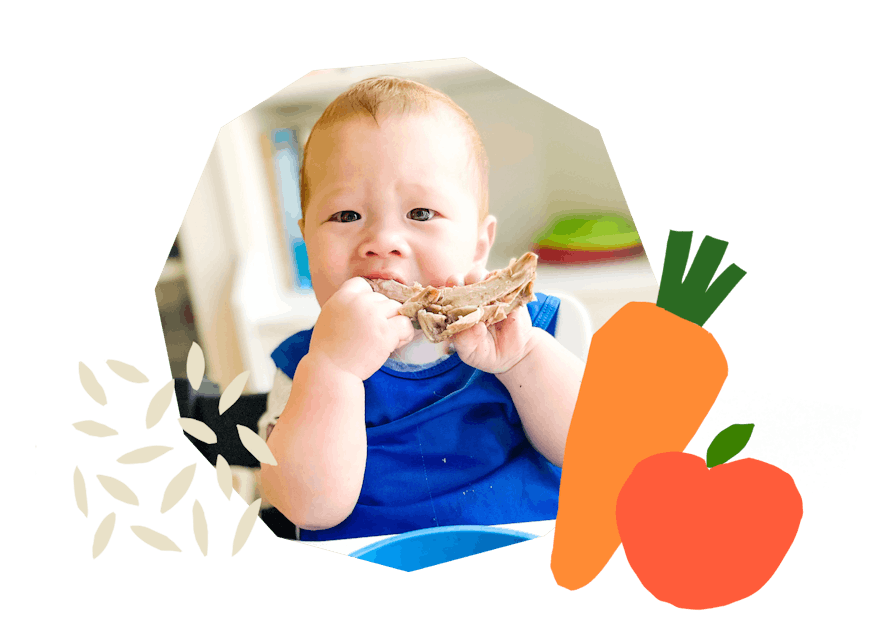
The Program Baby-Led Weaning with Katie Ferraro
A step-by-step digital program for starting solid foods safely and navigating the original 100 FIRST FOODS™ meal plan with baby-led weaning.
 EXPERT-LED, PROVEN APPROACH TO EATING REAL FOOD
EXPERT-LED, PROVEN APPROACH TO EATING REAL FOOD CONCISE VIDEO TRAININGS TO MASTER BABY-LED WEANING
CONCISE VIDEO TRAININGS TO MASTER BABY-LED WEANING 100 FIRST FOODS DAILY MEAL PLAN WITH FOOD PREP VIDEOS
100 FIRST FOODS DAILY MEAL PLAN WITH FOOD PREP VIDEOS
Baby-Led Weaning for Beginners Free Workshop
Is your baby ready to start solid foods, but you’re not sure where to start? Get ready to give your baby a solid foundation to a lifetime of loving real food…even if you’re feeling overwhelmed or confused about this next stage of infant feeding.
Get baby-led weaning recipes and tips delivered to your email inbox.

